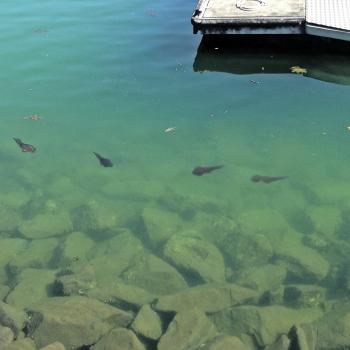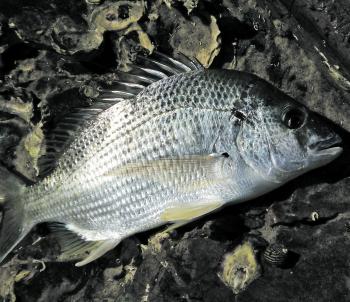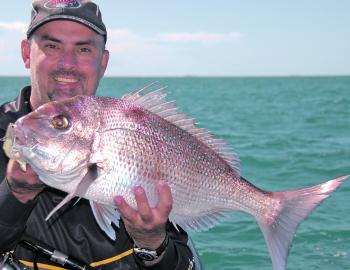Now that we are flush in the middle of winter, anglers will already have a good indication of the scope of piscatorial targets on offer. Species such as mulloway, snapper, luderick, squid, bream, tailor and numerous others will be on anglers’ hit lists.
Anglers have already experienced some exciting fishing for these species. The best action is yet to come. Increasing numbers of tailor and bream will be noticed in the coming weeks and anglers with a sound knowledge of these species will be able to reap the piscatorial rewards.
Good numbers of bream should enter the estuaries over the coming weeks with the full moon period often heralding a mass migration to inshore waters. Bream congregate in these zones for mating and they are ravenous, to say the least. Large numbers can often be caught within a few hours, as they will school in certain areas. Deeper channels entering the estuaries, river mouths, deeper holes and areas with abundant baitfish activity are all worth targeting.
Nights commonly produce the better fishing in the main channels, especially around the full moon when larger numbers of bream make their inshore migration. Bream are primarily opportunistic feeders and scavengers, eating most food items they come across. Naturally, quality fresh or live baits will always get the most attention, especially from those larger, more wary individuals.
Finesse rigging with light fluorocarbon leaders, a minimum of lead and hooks hidden in the bait (with the point just slightly exposed) will always achieve the better results. Saying this, quality bream can be caught on the crudest of tackle and poor quality baits by inexperienced anglers, however you certainly put the odds in your favour by using quality baits and rigging.
Some of the more popular baits are prawns, yabbies and worms. Others including pilchard strips, fillet baits, raw chicken fillet, squid strips, dough baits, whitebait, mullet gut, fowl gut and a heap of others will all work well. Berley can also be used and will bring larger numbers of fish to your area, getting them in a feeding mood. Chicken pellets soaked with tuna oil are a common and easy-to-source berley.
Minced fish offcuts, pilchards, prawn shells, bread crumbs and other morsels are also often added to the mix. This can be dispensed using a berley pot when in deeper areas or broadcast manually in shallower waters. Adding a little sand to the mix will help to get the berley down, sinking it a bit quicker into the strike zone.
Avoid using too much berley, as you only want to give the fish a taste, not feed them. Also beware of berleying in strong currents, because you can take the fish away from your area. Be aware that berleying can also attract undesirables such as rays, sharks, catfish and pike eels in some areas.
Bream are also very responsive to a broad array of artificials. Anglers skilled in the use of lures regularly score numbers of bream using minnow lures, blades, soft plastics, topwater offerings, flies and numerous others. Being skilled in the use of these and knowing what is best to use in which situation definitely comes down to time on the water. You can get the basics through research, but a natural instinct for it will reap rewards in fishing.
While tailor numbers have been sporadic over the previous months, increased captures of tailor should be forthcoming in the next month or so. Quite a few quality tailor have been caught in the Brisbane River in recent weeks, especially by anglers casting lures around well lit areas at night.
Additionally the retaining wall at the mouth, around the oil pipeline, Sunken Wall, Gateway Bridge and several other areas have produced tailor for anglers on baits and lures during daylight hours. The average fish have been around 40cm, however specimens to 50cm+ have been caught. Early morning rising tides have often produced some of the better catches.
Tailor have also been taken around the artificial reefs, mainly by anglers casting vibes and soft plastics. The shallows around the Bay Islands are another place worth looking and more than one angler has had their squid jig or small minnow lure snipped off by a ravenous greenback.
A few tailor have been caught from the shore at Red Beach, the Scarborough Jetty, Woody Point Jetty, Manly Rock Wall and numerous other places accessible via Shanks’ pony (walking). The eastern facing beaches of Stradbroke and Moreton should see increased numbers of tailor in the coming weeks. Pilchards, gar and salted tuna strips are great baits for tailor on the beaches, especially the larger greenbacks. Night sessions often produce some of the best catches, especially around the high tide.
Cephalopod numbers have been good in recent weeks with the eastern side of the bay producing some of the most consistent catches. The Rous Channel, Rainbow Channel, weed beds on the western side of Moreton and Stradbroke and the Blue Hole have produced great numbers.
Drifting in the channels with egi or baited skewers aft often rewards anglers with both arrow and tiger squid. Casting to the darkened areas along the edges of these channels on the falling tides is also worth the effort. The shallows around the Bay Islands have been worth probing with egi as quality tiger squid are usually in residence.
Land-based anglers have been doing fairly well at night around the foreshores at Manly, the Wellington Point Jetty, Scarborough area, Victoria Point and Wynnum Foreshore. These areas can still produce during daylight hours however the squid will generally come into shallower water at night and they can easily be located with high powered torches or head lamps before tempting them with an egi. Refusals are common in these heavily fished areas and several egi changes may be required until you get the squid’s commitment.
From mid-May, numbers of snapper have been healthy throughout Moreton Bay. The usual locales including the margins of the Bay Islands, artificial reefs, wrecks and rubble grounds have all produced quality knobbies as well as plenty of smaller snapper.
Anglers fishing baits have been commonly anchoring on these grounds during the early morning and late afternoon. Smart anglers are fishing quality baits with a minimum of lead to get them into the lower third of the water column. Heavily weighted baits don’t present as naturally when anchored to the bottom with a large dropper sinker.
It’s said that when fishing for bay snapper, you should just consider them as ‘large bream’ and fish accordingly with a running ball sinker rig. Casting up current from the anchored boat and allowing the current to transport the bait downstream will often produce those better quality knobbies. Fishing on the drift a paternoster style rig with a small lead will still present well and minimise snagging.
Snapper will accept a broad array of baits from live offerings to the humble frozen pilchard. Fresh is always better than frozen and it is always advisable to use the best quality baits you can source. Large fresh banana prawns can be fished on a jighead and drifted just off the bottom for good results on snapper and a host of other species. Fillet baits like tuna, bonito, gar, pike, mullet and a host of others can be presented as a strip bait on a set of snelled octopus hooks.
Pilchards are often presented on ganged hooks. Due to the snapper’s habit of mouthing the bait before swallowing, the more flexible and less obvious snelled rig is a better option. Small live baits such as yakkas, slimy mackerel, mullet and squid are numero uno and taking the time to source these will generally pay off. Previously frozen baits such as pilchards, squid, gar, baby octopus and several others will still produce some creditable snapper and other species within the bay.
Soft plastics and vibration baits are especially productive offerings for those who like to target snapper on lures. These are commonly cast up current and retrieved with the current using a slow roll or a series of lifts, winds and pauses. Trolling minnow lures has become another popular way to score a few snapper and will also produce cod, tuskfish, mackerel and a few other species around the fringes of the Bay Islands and numerous patches of rubble and coffee rock throughout the bay. Deep swimming minnow lures that dive 4-8m are commonly used.
The same baits and techniques described for snapper will also work on mulloway. While mulloway are still found in many of the same areas throughout the bay that the snapper are, they are more widespread in estuarine waters. The rivers and estuaries are prime places for mulloway and where most are caught.
The Brisbane River holds substantial numbers and anglers with good sounder skills usually have no trouble locating them. Good paces to try your luck include the areas adjacent to the wharves and jetties, Claras Rocks, around the Gateway Bridge, the deeper dredge holes along the retaining wall at the mouth, the submerged ledge just upriver from the sewerage shute, the eastern end of the oil pipeline and numerous spots along the edge of the main river basin.
A broad array of baits will work, but live offerings are definitely the best. These can include herring, pike, mullet, large prawns and gar. Vibration baits and plastics are the most commonly thrown artificials, however a broad array can be used successfully. Locating areas where baitfish and prawns are congregating is a good ploy, as mulloway will generally be close by.
Often you will be able to locate these baitfish schools and the mulloway, threadfin, snapper and other species feeding on them by using the side scan on a quality sounder. From here it’s just a case of casting and working your lure until you get a result. This usually doesn’t take too long, as these fish are already in a feeding mood and will pounce on most quality offerings.
There are still plenty of quality luderick around for anglers who target them. This mainly vegetarian species is generally targeted on weed baits suspended beneath a near neutral buoyancy float. Luderick are commonly found around estuarine and canal rock walls and deeper channels where numerous types of weeds grow. Cabbage weed is the most commonly found and used weed in our neck of the woods.
It can be located on most hard structures in the estuarine environment including rock walls, channel markers, buoys, floating pontoons and jetty pylons. Luderick can be very pedantic in their feeding habits at times and will gently mouth the bait.
Watching your float as it drifts with the current is the only way to determine if a luderick is mouthing the bait. The float may dip or rise a fraction or just slow down its passage to indicate a bite. An abrupt lift of the rod tip will set the hook and the dogged battle is on. Keep luderick alive until you are ready to process them. Otherwise the flesh may take on a bad flavour. Bleed, fillet, cut out the black gut lining and skin the fillets immediately and you will have some incredibly tasty fish.
Although the cold winter conditions are a deterrent for many, there are a lot of quality species to be taken during July. Daytime sojourns can be rather enjoyable, providing the wind is minimal and the sun is beating down. Early morning, evening and night trips will require plenty of warm clothing and a flask of soul defrosting coffee or soup.
With plenty of action throughout Moreton Bay and the numerous estuarine zones and rivers over the coming weeks, there will be plenty of incentive to get you out on the water. You will forget about the cold once you are hooked up to a rampaging knobby, mulloway, tailor or one of the other species that the Great South East has on offer during July.
Reads: 5007
Squid can often be sighted during daylight hours around the rock walls in the harbours and canals. This quartet was sighted in the middle of the day near the Raby Bay fuel dock.

Stud bream, like this 30cm model, will be a lot more common throughout the rivers and estuaries during July.

A broad array of plastics, vibes and other lures will tempt bay snapper. This fellow succumbed to a Samaki Thumpertail slowly rolled close to the bottom around an artificial reef.




